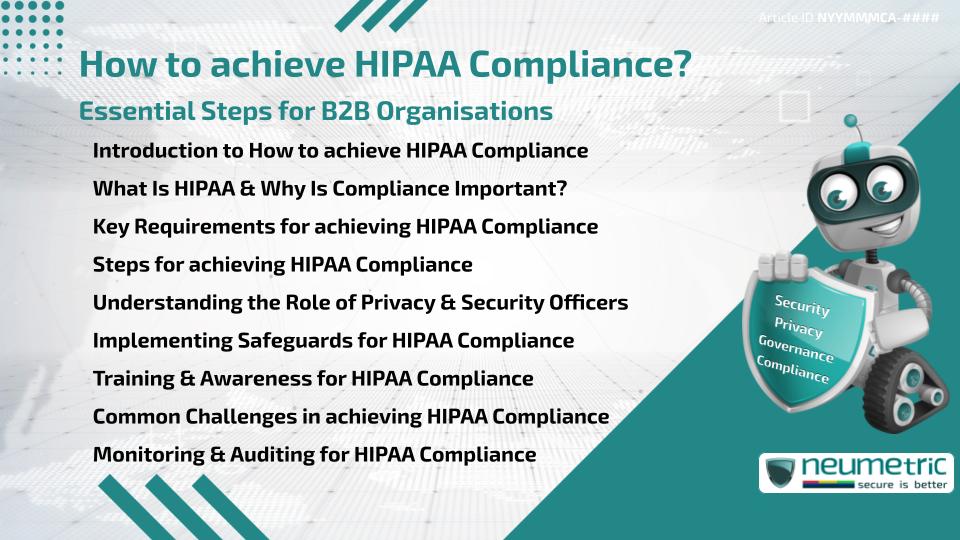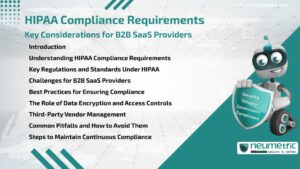Table of Contents
ToggleIntroduction to How to achieve HIPAA Compliance
Healthcare organisations, from hospitals to insurance companies, are responsible for safeguarding sensitive health information. achieving HIPAA compliance is a critical process that ensures organisations protect Patient Data in accordance with the Health Insurance Portability & Accountability Act [HIPAA]. In this article, we’ll break down the essential steps & practical tips for achieving HIPAA compliance.
What Is HIPAA & Why Is Compliance Important?
The Health Insurance Portability & Accountability Act [HIPAA] was established in 1996 to ensure the confidentiality & security of patient health information. HIPAA compliance means meeting the requirements set by the U.S. Department of Health & Human Services [HHS], which governs how Healthcare providers, insurers & others in the Healthcare industry handle sensitive health information.
Achieving HIPAA compliance is vital because failing to protect Patient Data can lead to severe penalties, legal repercussions & loss of trust. it ensures that personal health information is kept secure & confidential, reducing the risk of data breaches & unauthorized access.
Key Requirements for achieving HIPAA Compliance
To achieve HIPAA compliance, organisations must meet specific security, privacy & breach notification standards. The key requirements include:
Privacy Rule
This rule governs how Protected Health Information [PHI] is used & disclosed. Organisations must ensure patient information is only shared for legitimate purposes like treatment or payment.
Security Rule
This rule establishes national standards for safeguarding electronic PHI. it requires physical, administrative & technical safeguards to ensure confidentiality, integrity & availability of data.
Breach Notification Rule
If a breach occurs, the organisation must notify affected individuals & report it to the U.S. Department of Health & Human Services [HHS] within a specified time frame.
Enforcement Rule
This rule details penalties for non-compliance, ranging from fines to criminal charges, depending on the severity of the violation.
Steps for achieving HIPAA Compliance
1. Conduct a Risk Assessment
Start by identifying potential risks & vulnerabilities to PHI. This assessment will guide your strategy for securing Patient Data.
2. Develop & Implement Policies & Procedures
Create comprehensive policies covering data protection, breach notification & how PHI will be used. Employees must be trained on these policies.
3. Implement Safeguards
Adopt physical, administrative & technical safeguards to protect PHI. For example, encrypt Sensitive Data, implement secure access controls & provide training to Employees.
4. Create an Incident Response Plan
Develop a response plan for data breaches. This plan should include steps for mitigating damage, notifying affected individuals & reporting the breach to the authorities.
5. Regular Audits & Monitoring
Ongoing Audits & monitoring are crucial to ensure compliance is maintained over time. Regular reviews help identify potential issues before they become significant problems.
Understanding the Role of Privacy & Security Officers
A Privacy Officer & Security Officer are essential in any organisation’s efforts to achieve HIPAA compliance. These individuals are responsible for overseeing the compliance process, monitoring security practices & ensuring all Employees are trained on privacy & security protocols. They also play a key role in managing Audits, responding to breaches & making recommendations for improvements.
Implementing Safeguards for HIPAA Compliance
Effective safeguards are at the core of HIPAA compliance. The three types of safeguards are:
Physical Safeguards
These include measures to protect physical access to systems containing PHI, such as secure workstations, locked file cabinets & controlled access to server rooms.
Administrative Safeguards
These are the policies & procedures that govern how information is handled, who has access & how breaches are managed. Regular staff training is also part of these safeguards.
Technical Safeguards
These include encryption, firewalls & secure authentication protocols that prevent unauthorized access to PHI stored electronically.
Training & Awareness for HIPAA Compliance
Training is a fundamental aspect of achieving HIPAA compliance. All Employees who handle PHI must receive regular training on privacy & security policies. This includes how to protect information, recognize potential security threats & follow the proper procedures for handling breaches.
Training ensures that staff understand the importance of compliance & the impact that breaches can have on patients & the organisation.
Common Challenges in achieving HIPAA Compliance
Achieving HIPAA compliance can be challenging due to several factors, including the complexity of the regulations & the continuous evolution of Cybersecurity threats. Some common challenges include:
- Lack of Resources: Smaller organizations may struggle to allocate sufficient resources for compliance.
- Employee Awareness: Training staff effectively & ensuring they stay informed about the latest regulations can be difficult.
- Third-Party Vendors: If your organization shares data with third-party vendors, ensuring their compliance is crucial to maintaining your own compliance.
Monitoring & Auditing for HIPAA Compliance
Once your organisation has achieved HIPAA compliance, the work doesn’t stop. Ongoing monitoring & Auditing are required to ensure that the safeguards remain effective. Regular Audits help detect vulnerabilities & ensure compliance with the latest HIPAA standards.
Takeaways
- HIPAA compliance is essential for healthcare organizations to protect sensitive patient information.
- Key steps include conducting risk assessments, implementing safeguards, & providing employee training.
- Regular audits & ongoing monitoring are crucial for maintaining compliance.
- Compliance requires commitment from all staff, with particular attention to privacy & security officers.
FAQ
What is HIPAA compliance?
HIPAA compliance refers to adhering to the rules & regulations set by the Health Insurance Portability & Accountability Act to protect patient health information.
How can I ensure my business is HIPAA compliant?
Conduct Risk Assessments, implement necessary safeguards, provide training & regularly Audit your systems to ensure compliance.
What happens if an organisation is not HIPAA compliant?
Non-compliance can result in severe penalties, including fines & criminal charges, as well as loss of reputation & trust.
Do third-party vendors need to be HIPAA compliant?
Yes, third-party vendors who handle Patient Data must also comply with HIPAA regulations to ensure the protection of patient information.
How often should a HIPAA Audit be conducted?
Audits should be conducted regularly, ideally annually, to ensure compliance is maintained & to address any vulnerabilities.
Need help?
Neumetric provides organisations the necessary help to achieve their Cybersecurity, Compliance, Governance, Privacy, Certifications & Pentesting goals.
Organisations & Businesses, specifically those which provide SaaS & AI Solutions, usually need a Cybersecurity Partner for meeting & maintaining the ongoing Security & Privacy needs & requirements of their Clients & Customers.
SOC 2, ISO 27001, NIST, HIPAA, HECVAT, EU GDPR are some of the Frameworks that are served by Fusion – a centralised, automated, AI-enabled SaaS Solution provided by Neumetric.
Reach out to us!





